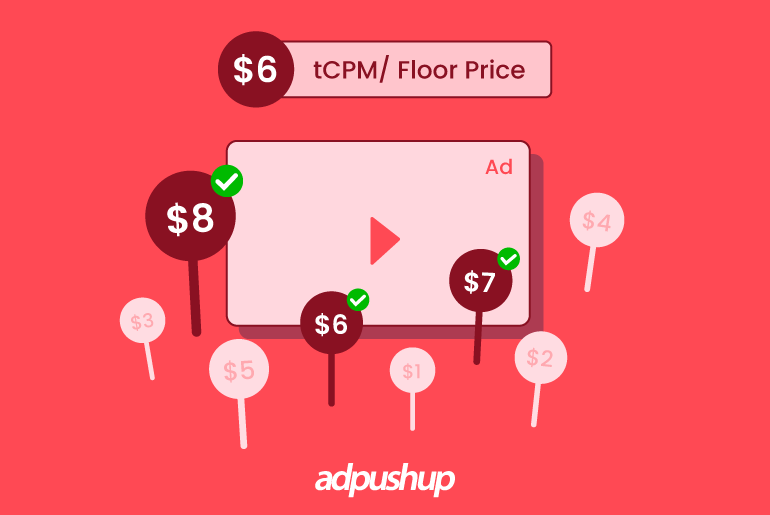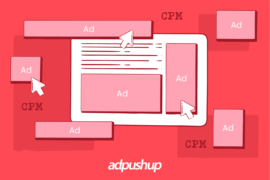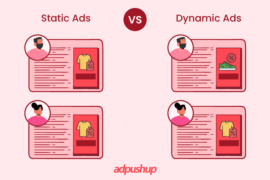Learn about Target CPM, what it is, how it differs from manual CPM, how it helps publishers increase their ad revenue and more.
Floor price allows publishers to set a minimum selling price for their ad inventory. Meaning when a bid appears for an ad unit, it is first filtered based on its floor price.
In order to maintain an optimum fill rate, publishers avoid setting a very high floor price.
Consequently, they sometimes end up selling their inventory at a lower value. Such cases are common and prevent publishers from utilizing the true potential of their inventory.
Considering these concerns, Google launched Target CPM on the Ad Manager platform.
What is Google Target CPM?
Target CPM (or tCPM) is a dynamically assigned floor price (CPM) for an ad unit. It can be lower or higher than the floor price set by the publisher. Google Ad Manager has designed tCPM to dynamically match the incoming bids while maintaining the target eCPM of the publisher.
Basically, this Google CPM metric is specifically designed to update the floor price as per the incoming bids to help publishers sell inventory at the best price.
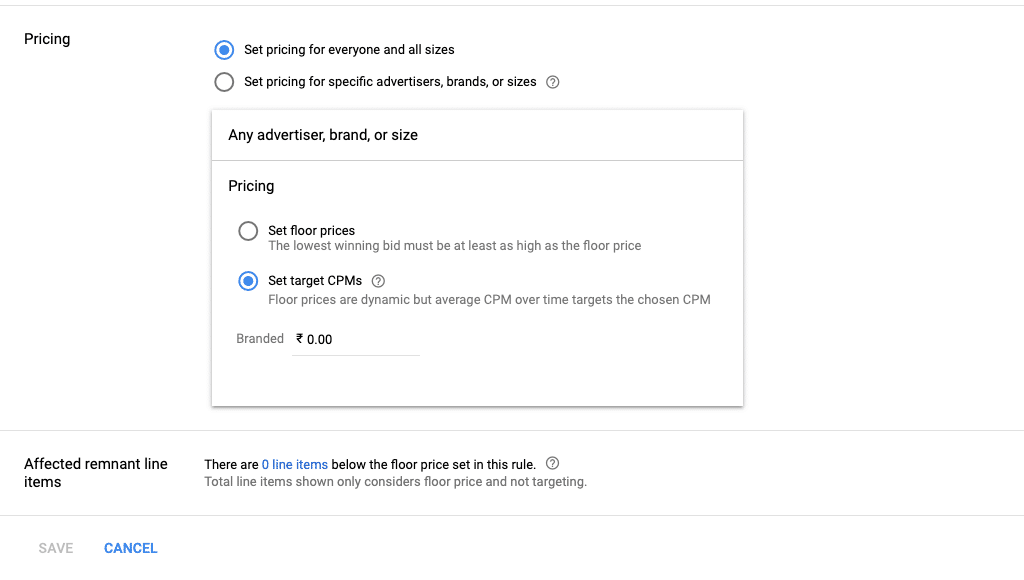
We’ll optimize your bids to help get as many impressions as possible using your target CPM (tCPM). Some impressions may cost more or less than your tCPM, but altogether Google Ads will try to keep your campaign’s average CPM equal to or lower than the tCPM you set.
Google
Think of Target CPM as dynamic pricing in air tickets. If you check flights for a particular day or time on multiple occasions, the price tends to go up. Similarly, in the case of this Google CPM, inventory that receives high competition and multiple bids from buyers, tCPM will dynamically increase its floor price.
How to Set up Target Google CPM?
Publishers can set up tCPM while creating a new ad unit. Or they can update existing ad units with new tCPM pricing rules.
Here are the detailed steps to set up inventory optimized for Target CPM:
- Go to Inventory > Ad Exchange rules > Pricing rules in Google Ad Manager account to start creating a new pricing rule.
- Click on Add new pricing rule, assign a name to the rule, and set the priority.
- Choose the part of inventory (Display, Mobile app, In-stream video or Games) where you wish to apply this pricing rule.
- Select the floor price, you can either enter a hard floor price or set it to Target CPM.
- Click Save to apply the target CPM rule on the inventory.
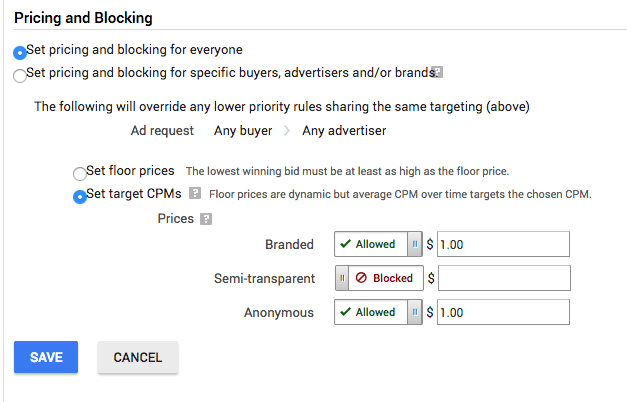
Note: The pricing rule applies to all ad sizes and layouts by default. You need to make customizations and choose specific brands, sizes, and advertisers that you wish to put under this rule. Also, ensure that you have disabled the “Everyone and all the sizes” setting.
Target CPM is only available for publishers who use Google Ad Manager. As Open Bidding (formerly known as Exchange Bidding) is one of GAM’s services, publishers can set tCPM for their EBDA inventory as well.
Since Google has adopted unified pricing rules, this header bidding alternative has become more flexible as now publishers can see real-time bids coming in for their inventory.
Is Target CPM Right for You?
As mentioned in the beginning, it dynamically increases and decreases floor prices to strike a healthy balance between fill rate and eCPM.
By enabling Target CPM, the fill rate should improve significantly. But publishers still need to work on user engagement and layout optimization to truly make this practice fruitful.
Hence, to truly understand whether tCPM is right for you, you need to test it. Google Ad Manager lets you conduct A/B tests for various placements and ad units. This includes tCPM. Here’s how you can experiment with tCPM in Google Ad Manager:
- Go to the Opportunities tab in your Google Ad Manager account.
- Select View opportunities and select the Opportunity types. Here, click Enable Target CPM for unified pricing rules.
- Next, click Experiment and assign a name to the experiment, for example, ‘target_CPM_exp1’.
- Define the start and end date for the experiment. Next, select the percentage of impressions you want to use in this experiment.
- Finally, click Start to launch the experiment.
At the end of the experiment, you can access the report and analyze the performance of the Target CPM on your inventory. Basis on this report, you can further add the pricing rule to various other ad units and advertisers.
What is the Difference Between Target CPM and Manual CPM?
In Google Ad Manager, there are important differences between manual CPM and target CPM. While target CPM can be a useful strategy for publishers, it doesn’t need to be used by every single publisher. The decision to use this CPM should depend on the inventory type and the publisher’s goals.
Manual CPM involves setting fixed prices, typically with relatively low rates, while target CPM allows publishers to increase fill rates and sell inventory at a reasonable value by creating pricing rules. It ensures a healthier CPM standard by filtering out lower bids that would otherwise be accepted in a manual strategy.
A Simple Mnemonic to Differentiate Target CPM and Manual CPM
In a manual CPM auction model, the buyer must meet or exceed the publisher’s set “hard price” to win the auction. However, with the activation of target CPM (tCPM) in Google Ad Manager (GAM), lower bids can be accepted to maintain a healthy overall cost per thousand impressions.
Regardless of whether you choose a manual CPM or target CPM strategy, it’s essential to continuously monitor performance and conduct various experiments to ensure the effectiveness of your strategy.
When it comes to header bidding, it is crucial for publishers to communicate the tCPM to demand partners. The bids received in header auctions may be lower than the set tCPM, necessitating the establishment of corresponding floor prices.
Conclusion
Target CPM should be considered as one way to set the floor price on your inventory rather than the only method. And again, testing is required before implementing Target CPM.
Publishers must understand that it is designed to first improve fill rate and then ad revenue. Implementing tCPM does save publishers from constantly monitoring and updating floor prices.
Finally, understand that CPM and ad revenue depend on a lot of factors, including geography, niche, placement, ad sizes, and the overall performance and demand for the inventory.
Frequently Asked Questions
It is calculated by dividing the total number of impressions by 1000 and multiplying it by CPM.
Total number of impressions = (Total cost of campaign / CPM) * 1000
CPM = Total cost of campaign / (Total number of impressions / 1000)
CPM is a short form for cost per thousand impressions. It is a formula that calculates the total ad spend for every thousand impressions on a web page.

Deepak has a keen eye for detail and a deep understanding of the ad tech landscape. Whether it’s through in-depth articles, thought-provoking insights, or compelling storytelling, he’s dedicated to helping people navigate the complex world of ad tech with the simplicity of his words.
